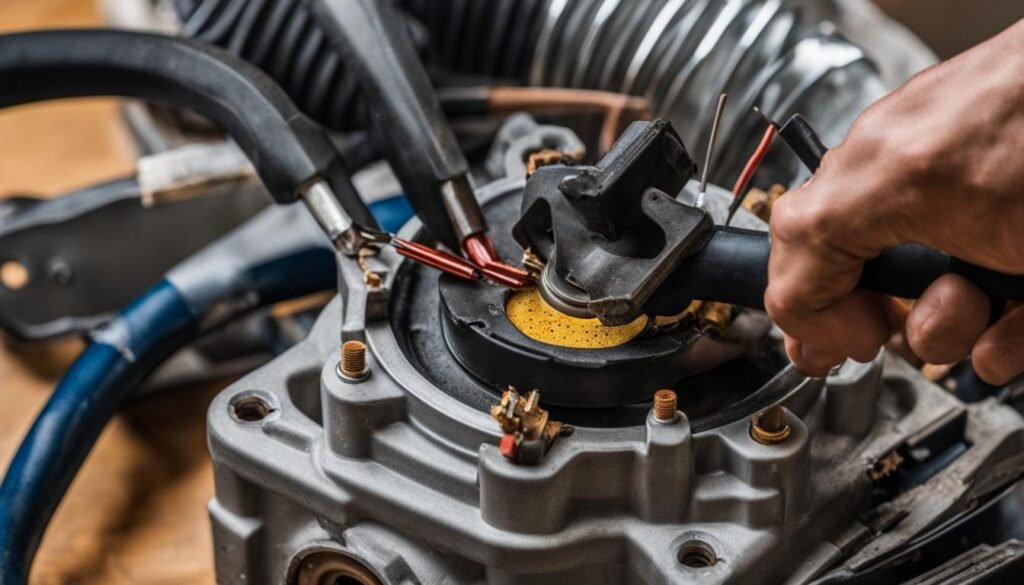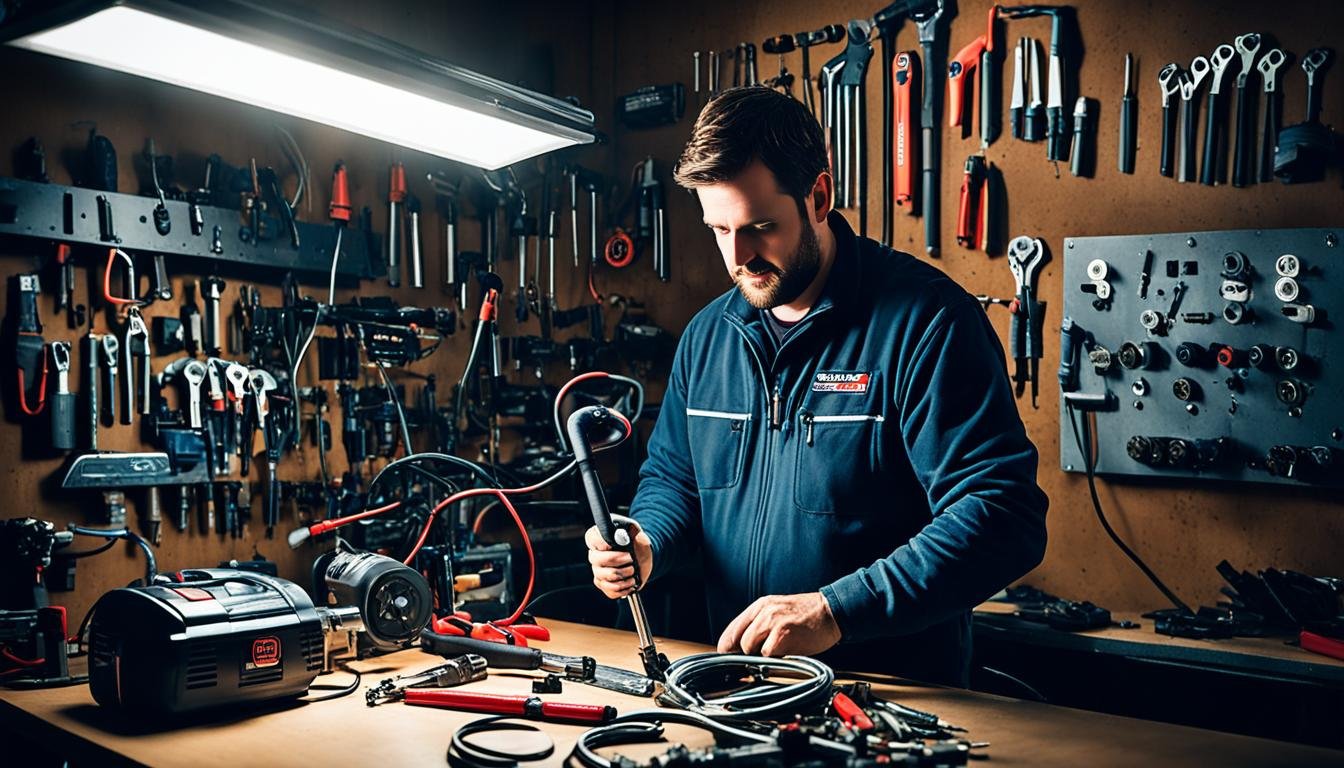When your vacuum cleaner motor stops working, troubleshooting is the first step to finding a solution. Vacuum cleaners rely on motors to create suction and power the brushroll for efficient cleaning. Understanding how vacuum cleaner motors work is essential for diagnosing and fixing issues. Common causes of motor failure include a defective on-off switch, a burned-out motor, or damaged motor brushes. In this guide, I’ll walk you through the steps to troubleshoot and repair these problems, so you can get your vacuum cleaner running smoothly again.
Key Takeaways:
- When your vacuum cleaner motor stops working, troubleshooting is necessary to identify the problem.
- Common vacuum cleaner motor problems include a defective on-off switch, a burned-out motor, or damaged motor brushes.
- Understanding how vacuum cleaner motors work is crucial for diagnosing and fixing issues.
- Regular maintenance is essential to prevent vacuum cleaner motor problems in the future.
- By following the step-by-step guide and performing regular maintenance, you can keep your vacuum cleaner motor running smoothly and extend its lifespan.
Understanding Vacuum Cleaner Motors
Vacuum cleaners come in various types, including upright, canister, wet/dry vacuums, and handheld models. Regardless of the type, all vacuum cleaners rely on a motor to create the necessary suction for drawing in dirt and debris.
Some upright models even have a second motor specifically designed to power the brushroll. The brushroll is responsible for dislodging debris from carpets, ensuring a thorough clean. Understanding how vacuum cleaner motors work, from creating suction to driving the brushroll, is crucial for troubleshooting motor-related issues.
When you turn on your vacuum cleaner, it activates an on-off switch that harnesses the power of electricity to drive a fan or blower wheel inside the motor. This fan or blower wheel creates suction, pulling air, dirt, and debris into a bag or canister for later disposal. The air, now free of dirt and debris, exits the vacuum cleaner through an exhaust port.
Vacuum Cleaner Motor Types
In addition to understanding the basic functionality of vacuum cleaner motors, it’s helpful to know about the different types available. While there are various motor types used in vacuum cleaners, the most common ones include:
| Motor Type | Description |
|---|---|
| Universal Motor | A compact and lightweight motor that operates at high speeds, making it suitable for portable vacuum cleaners. It runs on both AC (alternating current) and DC (direct current) power sources. |
| Induction Motor | A more robust and durable motor typically found in larger, heavy-duty vacuum cleaners. It operates on AC power and offers higher torque for enhanced suction power. |
| Brushless DC Motor | A more efficient and energy-saving motor design that eliminates the need for carbon brushes. It offers increased longevity and quieter operation compared to traditional brushed motors. |
Understanding the type of motor in your vacuum cleaner can provide valuable insights when diagnosing and troubleshooting motor-related issues.
Common Vacuum Cleaner Motor Problems and Solutions
When it comes to vacuum cleaner motors, there are several common issues that can arise. These problems can prevent the motor from working properly, affecting the overall performance of your vacuum cleaner. In this section, I will discuss some of the signs of a faulty vacuum cleaner motor and provide steps to repair it.
Signs of a Faulty Vacuum Cleaner Motor
There are a few signs that indicate your vacuum cleaner motor may not be functioning correctly. One of the most obvious signs is when the motor stops working entirely. This could be caused by a variety of factors, such as a defective on-off switch or a burned-out motor. Another sign is a decrease in suction power. If you notice that your vacuum cleaner is no longer picking up dirt and debris as effectively as before, it could be due to a faulty motor. Additionally, unusual noises coming from the motor or a burning smell when the vacuum cleaner is in use are also indicators of motor problems.
Steps to Repair a Vacuum Cleaner Motor
Repairing a broken vacuum cleaner motor may seem daunting, but with the right steps, it can be manageable. Here are the steps you can take to fix a faulty motor:
- Step 1: Begin by unplugging the vacuum cleaner from the power source to ensure your safety.
- Step 2: Check the on-off switch for any signs of damage. Test the switch for electrical continuity using a multimeter. If the switch is defective, it may need to be replaced.
- Step 3: If the motor is burned out or does not rotate freely, it may need to be replaced. Check the motor bearings for any signs of seizing or damage. Lubricate the bearings if necessary. If the motor cannot be repaired, consult the vacuum cleaner’s manufacturer or a professional technician for a replacement.
- Step 4: Inspect the motor brushes for any signs of wear or damage. Damaged brushes can impede the flow of electrical current and cause motor failure. Replace the brushes if needed.
- Step 5: After troubleshooting and repairing the motor, reassemble the vacuum cleaner and test it to ensure it is functioning correctly.
By following these steps, you can effectively diagnose and repair a vacuum cleaner motor that is not working properly, saving you from expensive repairs or having to purchase a new vacuum cleaner.

Common Vacuum Cleaner Motor Problems and Solutions
| Problem | Solution |
|---|---|
| Defective on-off switch | Test the switch for electrical continuity and replace if necessary. |
| Burned-out motor | Check the motor for signs of seizing or damage. Lubricate or replace the motor as needed. |
| Damaged motor brushes | Inspect the motor brushes for wear or damage and replace if needed. |
Table: Common Vacuum Cleaner Motor Problems and Solutions
Maintaining Your Vacuum Cleaner Motor
To keep your vacuum cleaner motor running smoothly and prevent motor issues, regular maintenance is key. By following these tips, you can extend the life of your vacuum cleaner and ensure optimal performance.
Clean the Motor and Fan Openings Regularly
Dust and debris can accumulate in the motor and fan openings, affecting the motor’s performance. To prevent this, make sure to clean these areas regularly. Use a soft brush or cloth to remove any buildup, ensuring that the motor can operate effectively.
Replace Worn or Damaged Components
Over time, components such as the drive belt and beater bar may become worn or damaged. Inspect these parts regularly and replace them if necessary. A worn or damaged drive belt can affect the motor’s ability to rotate the brushroll, leading to reduced cleaning efficiency.
Use the Appropriate Lubrication for Motor Bearings
Motor bearings require proper lubrication to ensure smooth operation. Different types of motors may have different bearing types, such as sleeve bearings or ball bearings. Consult your vacuum cleaner’s user manual or manufacturer for the recommended lubrication type and frequency.
Schedule Regular Maintenance According to Manufacturer’s Guidelines
Each vacuum cleaner model may have specific maintenance recommendations from the manufacturer. It’s important to follow these guidelines and schedule regular maintenance to keep your vacuum cleaner motor in optimal condition. This may include tasks such as filter replacement, brushroll cleaning, or overall system inspection.
Conclusion
Fixing and maintaining your vacuum cleaner motor is crucial for ensuring optimal performance and longevity of your appliance. By following a few simple tips, you can keep your vacuum cleaner running smoothly for years to come.
First, it’s important to understand how vacuum cleaner motors work and familiarize yourself with common motor problems. By troubleshooting issues such as a defective on-off switch, a burned-out motor, or damaged motor brushes, you can identify the root cause of the problem and take necessary steps to fix it.
In addition, regular maintenance is key to preventing motor issues. Make sure to clean the motor and fan openings regularly to remove dust and debris that can affect motor performance. Replace worn or damaged components and use the appropriate lubrication for motor bearings to ensure proper functioning.
By taking these steps, you can maintain and repair your vacuum cleaner motor effectively, extending its lifespan and keeping your appliance in excellent working condition. With a well-maintained motor, you can enjoy efficient cleaning and a freshly cleaned home.
FAQ
How do I troubleshoot a vacuum cleaner motor?
To troubleshoot a vacuum cleaner motor, start by checking the on-off switch for any electrical continuity issues. If the switch is functioning properly, inspect the motor brushes for damage or wear. You should also examine the motor for signs of damage or burning. If necessary, replace the motor or brushes to fix the issue.
What are signs of a faulty vacuum cleaner motor?
Some signs of a faulty vacuum cleaner motor include the vacuum not turning on, a burning smell coming from the motor, a decrease in suction power, or abnormal noises. If you notice any of these signs, it’s likely that your vacuum cleaner motor is experiencing issues.
Can I replace a vacuum cleaner motor myself?
Yes, you can replace a vacuum cleaner motor yourself if you have the necessary tools and expertise. It’s important to consult the manufacturer’s instructions and follow the proper steps to ensure a successful replacement. However, if you’re unsure or uncomfortable with performing the repair, it’s recommended to seek professional assistance.
How often should I clean and maintain my vacuum cleaner motor?
It’s recommended to clean and maintain your vacuum cleaner motor regularly to keep it in good condition. Cleaning the motor and fan openings every few months and replacing worn components, such as the drive belt and beater bar, will help maintain optimal performance. Additionally, following the manufacturer’s guidelines and performing routine maintenance will prolong the lifespan of your vacuum cleaner motor.
What can I do to prevent vacuum cleaner motor issues?
To prevent vacuum cleaner motor issues, it’s important to practice regular maintenance. This includes cleaning the motor and fan openings, replacing worn components, and lubricating motor bearings as needed. Additionally, avoid overloading your vacuum cleaner and use it on appropriate surfaces to prevent excessive strain on the motor. Following these tips will help prevent motor problems and extend the life of your vacuum cleaner.





Leave a Reply